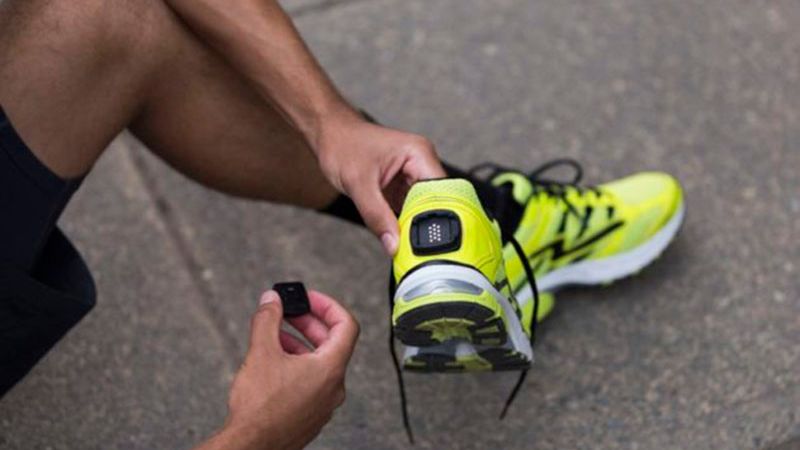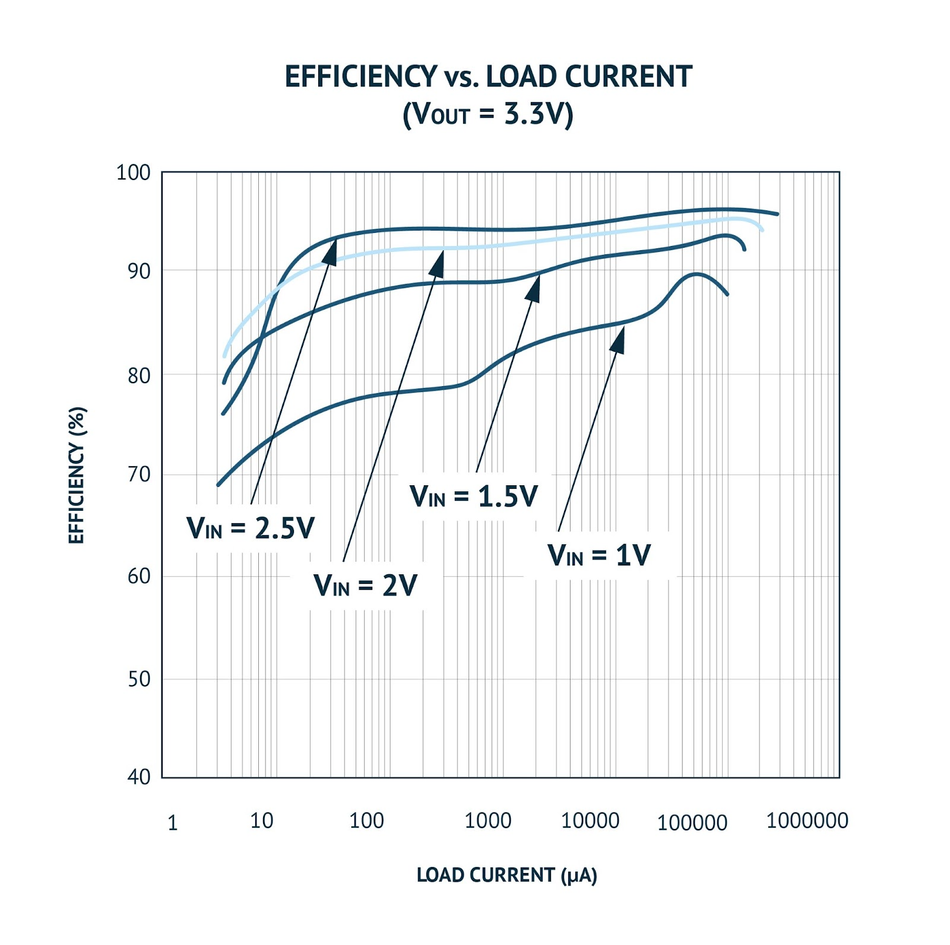Nano Power Converters for Extending the Battery Life of Small IoT products
Article #8 of Power Management for Tomorrow’s Innovations Series: Power electronics converters with an efficiency of up to 95% and very low quiescent current can make the Internet of Things devices last for months together.

Image credit: Sensoria
This is the final article in an 8-part series featuring articles on Power Management for Tomorrow’s Innovations. The series focuses on power management and optimization techniques for modern electronic systems. This series is sponsored by Mouser Electronics. Through the sponsorship, Mouser Electronics shares its passion for technologies that enable smarter and connected applications.
One of the biggest hurdles in increasing the adoption of Internet of Things (IoT) devices today is battery life. IoT devices running out of juice frequently is not only annoying for users but can have devastating effects in industrial space. As research continues to improve the charge-holding capacity of batteries, power converters must also evolve to optimize the use of all the available energy.
This article presents a specific IoT power management solution for small, portable gadgets while also reviewing its shortcomings. We then introduce a nano-Power boost converter that overcomes these shortcomings while ‘operating on fumes’ down to minimal amounts of residual battery energy.
Typical Power Solution for Small IoT Products
To understand the power needs of a typical small IoT product, let’s consider the example of a wearable heart monitoring patch. A wearable heart monitoring patch is a tiny device that must last for a long time; hence minimization of the size and power dissipation is crucial.
Such devices can be powered by a 100mAh alkaline button cell and can consume around 100µA in operation. In such a scenario, the device may last three weeks. On the other hand, in shutdown mode, the device may need to last up to three years, which requires a leakage current of 4µA or less. A typical voltage regulator, with a leakage current of 0.2µA and a total quiescent current of 10µA, could rob 1.8 months from the device’s shelf life and two days of operation.
Maintaining high efficiency and small size both together is a challenging requirement. Increasing the frequency of operation reduces the size of passives while increasing losses, thereby reducing efficiency. The proliferation of portable IoT devices creates a need for multiple customized versions of voltage regulators, especially concerning output voltage and current specifications. Accordingly, an IoT device manufacturer may get forced to maintain a sizeable and costly inventory of different regulators and the passives required to support them.
A State-of-the-Art Solution for Powering Small IoT Products
The ideal solution to power small IoT devices is a voltage regulator that addresses these shortcomings. Let’s take a look at Analog Devices MAX17222 nanoPower synchronous boost converter and understand how a power converter contributes to energy and space-saving in small IoT devices.
MAX17222 offers a 0.4V to 5.5V input range, a 0.5A peak inductor current limit, and an output voltage selectable using a single standard 1% resistor. A novel True Shutdown™ mode yields leakage currents in the nanoampere (nA) range, making this a genuinely nanoPower device! The essential elements of the MAX17222 concerning shutdown and quiescent currents are shown in Fig. 2 below.
The True Shutdown feature disconnects the output from the input with no forward or reverse current, resulting in a very low leakage current. The reduction in shelf life we calculated for the specific solution is 1.8 months out of 3 years for a 100mAh cell. With 0.5nA leakage current, the shelf life for the same cell over three years gets reduced by only 3 hours!
If a pull-up resistor is employed to enable/disable operation, the pull-up current in True Shutdown mode must also get accounted for. If the enable (EN) pin gets driven by a push-pull external driver powered by a different supply, then there is no pull-up current, and the shutdown current is only 0.5nA.
The Quiescent Current Advantage
The input quiescent current (IQINT) for MAX17222 is 0.5nA (Enable open after startup), and the output quiescent current (IQOUT) is 300nA as shown in fig. 3. The additional input current needed to feed the output current (I>QOUT_IN) must be added to IQINT to calculate the total input quiescent current. Since the output power is related to the input power by the efficiency (POUT = PIN × η), it follows that:
IQOUT_IN = IQOUT × (VOUT/VIN)/η
If VIN = 1.5V, VOUT = 3V and efficiency η = 85%, we have:
IQOUT_IN = 300nA × (3/1.5)/0.85 = 705.88nA
One adds the 705.88nA to the input current of 0.5nA yields a total input quiescent current of 706.38nA (IQINGT). This calculation is fourteen times better than the typical case previously discussed. With 0.7µA of quiescent current, the two days of reduced operation calculated for the specific solution becomes only three and a half hours.
Enable Transient Protection Mode
The MAX17222 includes an option to Enable Transient Protection (ETP) mode. When activated by the presence of a pull-up resistor, extra on-chip circuitry powered by the output capacitor assures that EN stays high during short transient disturbances at the input. This feature is essential to prevent the device from shutting down unintentionally during short transients. When the device operates in ETP mode, the quiescent current calculated above increases by a few tens of nanoamps.
The RSEL Advantage
The MAX17222 trades off the traditional resistor-divider used to set the output voltage value with a single output selection resistor (RSEL) (Fig. 3). The chip uses up to 200μA to read the RSEL value at startup. This occurs only during the select resistor detection time (typically 600µs), virtually eliminating the continuous contribution of RSEL to the quiescent current.
A single standard 1% resistor sets one of the 33 different output voltages, separated by 100mV increments between 1.8V and 5V. The result is a slight reduction in the Bill Of Materials (BOM) (as the design has one less resistor compared to the conventionally used potential-divider circuit) and a lower quiescent current.
The Efficiency Advantage
The MAX17222 features low RDSON, on-board powertrain Metal–Oxide–Semiconductor Field Effect Transistor (MOSFET) transistors to yield excellent efficiency even when operating at frequencies high enough to warrant a small overall PCB size. The low quiescent current design extends the outstanding efficiency performance down to a few microamps of load current. Fig. 4 shows the efficiency curves for the MAX17222 for varying load currents at different input voltages.
Conclusion
The IoT market has generated an explosion of small, wirelessly connected, battery-operated devices. These devices continue to lower the power loss boundaries for operation (efficiency) and shutdown (leakage current). As battery technologies continue to evolve and get better at holding charge, advancements in power electronics must go hand in hand to meet the growing needs of miniature IoT devices.
For small IoT product development, engineers can use power converters such as Analog Devices MAX17222 ultra-low quiescent current, high-efficiency synchronous buck converter to significantly increases IoT devices’ shelf and operation life.
This article is based on an e-book by Mouser and Analog Devices. It has been substantially edited by the Wevolver team and Electrical Engineer Ravi Y Rao. It's the final article from the Power Management for Tomorrow’s Innovations Series.
The introductory article covered the fundamentals of power electronics, the technology behind highly-efficient power conversion in different electrical/electronic systems.
The first article shares some design techniques for efficient power management in EVs. It covers how manufacturers can build significantly better vehicular electric power systems with systematic planning and innovative power electronic solutions.
The second article introduced readers to silent switching and how it prevents EMI at the source, rather than adding shields and filters to the product later.
The third article describes current measurement techniques using LTC297x series components by Analog Devices. It presents some application circuits and compares different approaches for current sensing in power electronic converters.
The fourth article discussed the problems associated with phase noise and experimentally showcased how power supply designs can be optimized to deal with them.
The fifth article featured Single-Inductor Multiple-Output architecture that integrates different power supply functionalities to drastically reduce the overall size and costs for wearables.
The sixth article describes how vehicular asset-tracking devices are powered with small, efficient power solutions and protected from electrical stresses.
The seventh article explains how designers can implement and validate proven power supply circuits for enabling the reliable operation of healthcare devices.
The final article dealt with a specific IoT power management solution for small, and portable gadgets. It showcases a nano-Power boost converter that ‘operates on fumes’ to make the most out of all the available energy.
About the sponsor: Mouser Electronics
Mouser Electronics is a worldwide leading authorized distributor of semiconductors and electronic components for over 1,100 manufacturer brands. They specialize in the rapid introduction of new products and technologies for design engineers and buyers. Their extensive product offering includes semiconductors, interconnects, passives, and electromechanical components.

References
[1] Make Your IoT Device Last Longer with a nanoPower Boost Converter Maxim Integrated (Analog Devices) and Mouser Electronics, [Online] , Available from:



